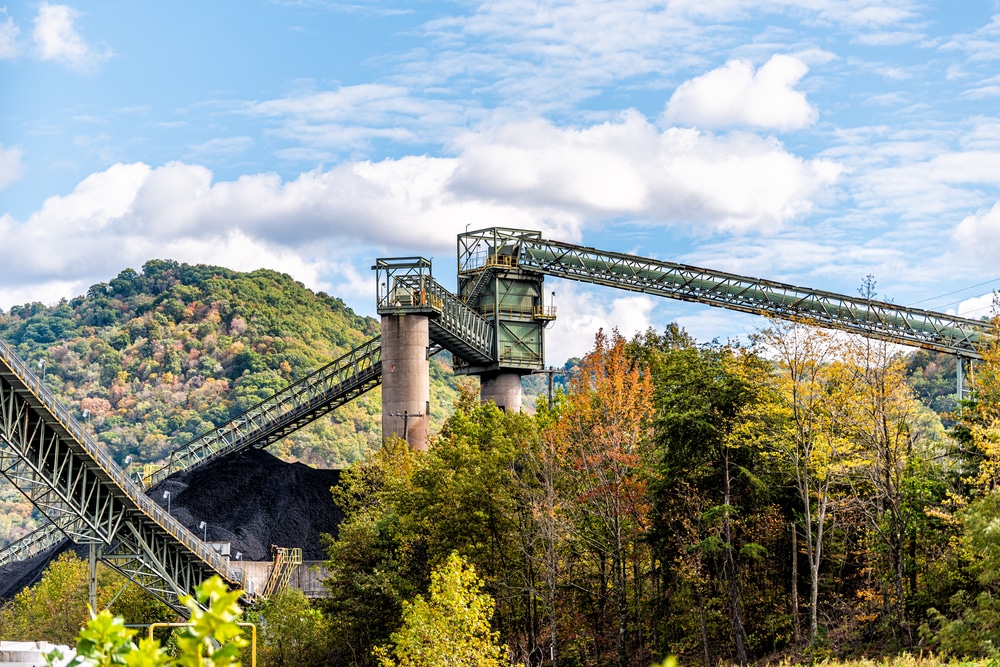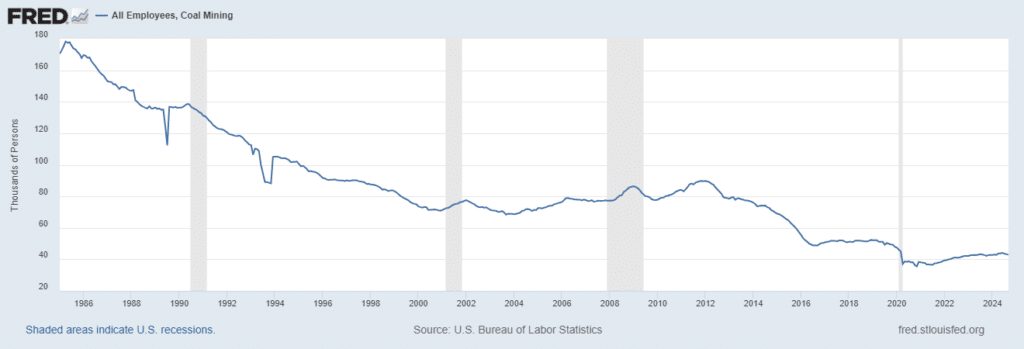From Coal Towns to Sunscapes: Renewables Reach Coal Country

Despite years of excitement about renewables, we’re not all that far removed from the days of King Coal.
As recently as the early 2000s, coal was the driving force for American electricity generation. According to the Energy Information Administration (EIA), coal accounted for 2,016 billion kilowatt-hours (kwH) of electrical generation in 2007.
Natural gas boomed soon after, eventually becoming the nation’s leading producer.
Today, coal only accounts for about 675 billion kwH, leapfrogged by natural gas, nuclear energy, and even renewables. But nothing happens overnight; the writing has been on the wall for years.
It also helps to keep everything in perspective. Yes, coal energy generation has fallen by two-thirds, but it still accounts for 16% of America’s energy portfolio.
A Black, White, and Gray Issue
Coal production capacity has fallen precipitously since the mid-2000s, decreasing by one-third from 2012 to 2022.
Though use and consumption fell, coal is still a critical energy source. Data from the EIA determined that 91% of coal consumed went to electric power.
As the country adopts more renewable energy, including solar, coal is slowly falling behind. Unfortunately, coal’s decline is also woven into several states’ economies and histories.
How can emerging technology and energy generation support these states, and is a coal-
free future possible?
Coal Meets Its Match
Since 2007, coal has seen its share of energy generation eaten up by cleaner, cheaper options.
Natural gas is plentiful and cost-effective, leading energy generation plants to switch from coal. Though still a fossil fuel, natural gas is more efficient than coal. It also produces much less carbon dioxide during energy generation.
Between 2011 and 2019, more than 120 coal-fired generation plants converted to other fuels. Of those, the vast majority became natural gas-powered. In states where natural gas is plentiful, like Texas, Florida, California, Pennsylvania, and Ohio, the decision felt immediate. By 2021, natural gas was the largest power generator in all five states.
Meanwhile, states like Iowa, Kansas, and South Dakota also distanced themselves from coal, investing in wind power. By 2021, wind was the largest share of electricity power generated in those states.
Weaning Off Coal
Despite clean energy advancements and ambitious net-zero emission goals, some states still depend on coal to survive.
West Virginia, Missouri, Wyoming, and Kentucky still rely heavily on coal. More than 70% of each state’s power comes from burning it, including more than 90% of West Virginia’s energy. Moreover, Wyoming, West Virginia, and Kentucky are several of the nation’s largest coal producers.
Despite their reliance on coal, all three states have tried to adopt more renewable energy.
For example, Wyoming established wind farms to take advantage of its windy conditions. More than 22% of the Cowboy State’s power comes from renewables now.
West Virginia and Kentucky have been slower, however. Less than 1% of Kentucky’s energy comes from renewables, while West Virginia fares slightly better at 4%.
Though the numbers don’t seem encouraging, there’s room for improvement. What we’re seeing across all three states are concerted efforts to improve energy diversity and promote new industries and jobs in economically depressed areas.
Why Renewables? Why Now?
It’s hard to break generational ties sometimes, but leaving coal in the dust could benefit everyone.
Renewables like solar and wind are on the upswing as technology improves. And for the people of coal country, adjusting to a solar-powered future could create more opportunities.
Pro-Environment Movement
One of the main drivers of renewable energy, including solar, is its ability to generate clean power.
Burning coal for energy creates several problems for the environment. First, it pumps greenhouse gases into the atmosphere at rates higher than other fuel sources.
Mining companies also commonly use surface mines to find and extract coal from the Earth. This process can cause coal dust to enter the air and water, impacting health.
Secondly, coal mining massively changes local landscapes. To reach underground seams, companies cut off mountain tops. The result is a litany of environmental concerns, ranging from human health issues to river damage, habitat destruction, and air pollution.

Emerging Job Markets
The U.S. Bureau of Labor Statistics (BLS) reports that coal mining jobs have dropped over 50% since January 2012.
Coal’s decline coincides with the recent rise in renewable energy jobs across the United States. According to E2, a nonpartisan group, nearly 560,000 Americans work in renewable energy generation, up 14% since 2020.
Job growth should remain strong throughout the rest of the decade as the U.S. invests in solar, wind, and other renewables.
Economic Factors
Not long ago, coal was one of the most cost-effective energy generation methods.
However, the rise of low-cost natural gas, rapidly decreasing solar costs, and battery storage solutions have impacted coal. Divesting from coal becomes easier once the numerous tax credits and government programs driving renewable adoption get involved.
The Government is Involved
Thanks to government support, there is no shortage of programs to make renewable energy attractive.
While the country moves closer to its net-zero carbon emissions goal, renewables will benefit from massive government investments.
The Inflation Reduction Act introduced and extended several programs and incentives, including ITCs and PTCs. Solar installers can also access DSIRE to find state and utility incentives.
Public Perception is Changing
Although coal still has a role in America’s energy portfolio, many people, organizations, and government officials want cleaner energy.
The reality is that coal jobs will likely continue dwindling. At the same time, new high-paying skilled jobs in solar and wind are coming in. For former coal towns, people can seamlessly move into a new, growing industry with a strong future.
Three States, Three Stories
Luckily, utility-scale solar isn’t strictly for sun-soaked states like California and Texas.
For states like Wyoming, West Virginia, and Kentucky, the race is on to pivot from coal to solar and wind. Coal is a hallmark of their economies, but money, people, and technology are helping them push toward solar.
Wyoming
The leading coal-producing state has started building one of the nation’s largest solar farms.
Wyoming is heavily involved in wind power, but solar is picking up steam. Currently, Wyoming ranks 46th in the nation for solar generation, per the SEIA, but recent developments will help the state evolve into a renewable energy powerhouse.
Totaling 771 MW, Cowboy Solar I and II will feature 400 and 371 MW utility-scale solar farms, respectively. The sites will also include battery storage systems of 136 and 133 MW.
Though the project is in its early stages, completing it would give Wyoming a massive shot of solar energy.
Kentucky
Kentucky ranks 43rd in the nation for solar generation but is a top-five coal producer.
Recent projects could add more than 950 MW of solar to the state’s portfolio. Developers recently broke ground on a 160 MW solar project in western Kentucky that could power up to 120,000 homes. Called Unbridled, the project will be the state’s largest solar installation once it goes live.
Another planned project on the eastern side of the Bluegrass State will soon be its largest by far. The 800 MW solar farm will begin construction in 2026 and could introduce hundreds of solar jobs to the region.
The prospective site sits on the former Starfire Mine, and its flat terrain is perfect for solar panels. It also has most of the infrastructure for connecting to the larger grid and moving materials and people.
West Virginia
West Virginia has made several moves to add more solar energy by giving new life to former mines.
A 250 MW solar farm located at an old mine began construction in 2022 and should be operational by the end of this year. Over the next five years, developers will start work on another 150 MW site with plans to complete it over the next decade.
The excitement for solar in West Virginia has seeped into the private sector, too. Titanium Metals Corporation, an aerospace manufacturer, could eventually run on only solar power. Plans to build the 106 MW solar farm with a 50 MW battery system should kick off in 2025.
The state is also home to groups like the Appalachian Climate Technology (ACT Now) Coalition, which represents 21 counties in West Virginia. Its mission is to introduce and promote clean energy jobs and projects where coal was once a major driver. Ultimately, the goal is to create new high-paying jobs in emerging industries.
What Have We Learned?
Developing a new industry where one didn’t exist is difficult but not impossible.
Thanks to mining, coal states like Wyoming, West Virginia, and Kentucky have the tools needed to support solar energy. Their infrastructure is largely in place, the landscape easily supports solar, and many workers are available. And, once again, the states aren’t abandoning coal – they’re simply diversifying energy sources.
The government also hasn’t lost sight of its own renewable energy goals. Federal and state governments have invested heavily in new technology by funding as many projects as possible. This support is critical for states as they switch from fossil fuels to clean energy generation.
We can’t expect change to occur overnight, especially with an industry as ingrained in our culture as coal. But with investment, time, and continued effort, it’s possible to chart a new path forward.


